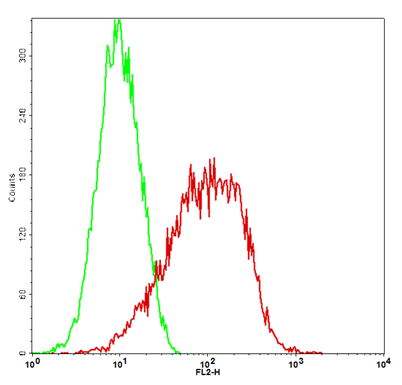Recombinant Human Interleukin-20/IL-20
Shipping Info:
For estimated delivery dates, please contact us at [email protected]
| Amount : | 50 µg |
| Content : | Lyophilized from a 0.2 µm filtered solution of 20mM PB, 150mM NaCl, pH 7.4. |
| Storage condition : | Lyophilized protein should be stored at -20°C, though stable at room temperature for 3 weeks. Reconstituted protein solution can be stored at 4-7°C for 2-7 days. Aliquots of reconstituted samples are stable at -20°C for 3 months. |
| AA sequence : | MLKTLNLGSCVIATNLQEIRNGFSEIRGSVQAKDGNIDIRILRRTESLQDTKPANRCCLLRHLLRLYLDRVFKNYQTPDHYTLRKISSLANSFLTIKKDLRLCHAHMTCHCGEEAMKKYSQILSHFEKLEPQAAVVKALGELDILLQWMEETE |
Source: E.coli.
MW :20.07kD.
Recombinant Human Interleukin-20 is produced by our E.coli expression system and the target gene encoding Leu25-Glu176 is expressed. Interleukin-20 (IL-20) is a member of the IL-10 family of regulatory cytokines that includes IL-10, IL-19, IL-20, IL-22, IL-24 and IL-26. Members of this family share partial homology in their amino acid sequences but they are dissimilar in their biological functions. IL-20 exhibits approximately 28% amino acid identity with IL-10 and 76% amino acid identity with mouse IL-20. There are two heterodimeric receptor complexes for IL-20. The first is composed of IL-20 Ra and IL-20 R beta. The second is composed of IL-22 R and IL-20 R beta. Whereas the IL-22 R/IL-20 R beta complex is shared with IL-24, the IL-20 Ra/IL-20 R beta complex is shared with both IL-19 and IL-24. IL-20 has been shown to initiate transduction cascades involving STAT3 and stimulates the induction of pro-inflammatory genes including TNF-a and MCP-1. Initial functional studies using transgenic mice suggest that IL-20 has the ability to regulate skin development. The over-expression of both human and mouse forms of IL-20 results in keratinocyte hyper-proliferation, abnormal epidermal differentiation, and neonatal lethality. In humans, IL-20 and its receptors are up-regulated in psoriatic skin, and polymorphisms in the IL-20 gene have been associated with plaque-type psoriasis. IL-20 may also have a role in hematopoiesis. It enhances the proliferation of multi-potential progenitors in vitro and increases their numbers and cell cycling status in IL-20 transgenic mice. IL-20 is also shown to suppress COX-2 and PGE2 and acts as an inhibitor of angiogenesis in model systems.
MW :20.07kD.
Recombinant Human Interleukin-20 is produced by our E.coli expression system and the target gene encoding Leu25-Glu176 is expressed. Interleukin-20 (IL-20) is a member of the IL-10 family of regulatory cytokines that includes IL-10, IL-19, IL-20, IL-22, IL-24 and IL-26. Members of this family share partial homology in their amino acid sequences but they are dissimilar in their biological functions. IL-20 exhibits approximately 28% amino acid identity with IL-10 and 76% amino acid identity with mouse IL-20. There are two heterodimeric receptor complexes for IL-20. The first is composed of IL-20 Ra and IL-20 R beta. The second is composed of IL-22 R and IL-20 R beta. Whereas the IL-22 R/IL-20 R beta complex is shared with IL-24, the IL-20 Ra/IL-20 R beta complex is shared with both IL-19 and IL-24. IL-20 has been shown to initiate transduction cascades involving STAT3 and stimulates the induction of pro-inflammatory genes including TNF-a and MCP-1. Initial functional studies using transgenic mice suggest that IL-20 has the ability to regulate skin development. The over-expression of both human and mouse forms of IL-20 results in keratinocyte hyper-proliferation, abnormal epidermal differentiation, and neonatal lethality. In humans, IL-20 and its receptors are up-regulated in psoriatic skin, and polymorphisms in the IL-20 gene have been associated with plaque-type psoriasis. IL-20 may also have a role in hematopoiesis. It enhances the proliferation of multi-potential progenitors in vitro and increases their numbers and cell cycling status in IL-20 transgenic mice. IL-20 is also shown to suppress COX-2 and PGE2 and acts as an inhibitor of angiogenesis in model systems.
Always centrifuge tubes before opening. Do not mix by vortex or pipetting. It is not recommended to reconstitute to a concentration less than 100 µg/ml. Dissolve the lyophilized protein in ddH2O. Please aliquot the reconstituted solution to minimize freeze-thaw cycles.
Endotoxin : Less than 0.1 ng/µg (1 IEU/µg) as determined by LAL test.
For Research Use Only. Not for use in diagnostic/therapeutics procedures.
| Subcellular location: | Secreted |
| Tissue Specificity: | Expressed in most tissues and five major cell types: epithelial cells (primarily skin, buccal mucosa, tongue, nasal mucosa, lung, ureter, breast, prostate, fallopian tube, and adrenal gland), myoepithelial cells (mainly prostate), endothelial cells (mainly in small vessels or capillaries), macrophages, and skeletal muscle. Isoform 2 was detected in the lung tissue only. |
| BioGrid: | 119086. 9 interactions. |
|
There are currently no product reviews
|
















.png)









